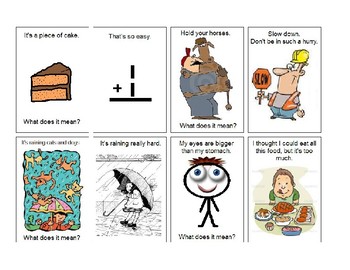Idiom Matching Cards with Pictures for Context - Set 1
Suddenly Tele-SLP
330 Followers
Grade Levels
1st - 9th
Subjects
Resource Type
Formats Included
- Word Document File
Pages
3 pages
Suddenly Tele-SLP
330 Followers
Description
More than half of my students have Autism or another disability which affects social/pragmatic language skills. They do not infer the meanings of everyday idiomatic expressions and these need to be taught explicitly and then applied in real life situations.
I have created three sets of matching cards (this is the first set) to help explicitly teach some of the common idioms used in the English language.
This is a simple product. I would print these on card stock so that you cannot see through the back and then laminate them to make them durable. Simply teach the idioms by introducing the idiom cards, showing the students the literal depiction of the meaning to illustrate how silly that would be if they were taken literally. You can then either: 1. go ahead and show them/and explain to them the real/intended meaning of the idiom with the picture, 2. or you can withhold the real meaning and provide a verbal description of a scenario that would provide some context to see if they can then infer the meaning (for example, after showing them the literal picture for "He's on cloud 9," you would say, "Someone might be on cloud 9 when it's their birthday." Hopefully the student will be able to infer that this means someone is happy. Then you can validate that response by showing them the intended meaning. If not, then you simply tell them.
After an initial review with these idioms, you can play a sort of matching game where the kids turn over the literal meaning, tell you the intended meaning, and then try to find it.
After the students have learned the meaning through rote memory, you'll want to make sure they can apply them. Find situations in which to use the idioms taught. In books that you read to the students, find situations in which the characters might say one of these idioms to another character.
I remember an instance where two of my students were looking for their sticker charts and one was in a particular hurry. The other student looked at him and said, "Hold your horses." I was so proud. It had been several sessions since we'd addressed it and here she was applying it in an appropriate context.
I have created three sets of matching cards (this is the first set) to help explicitly teach some of the common idioms used in the English language.
This is a simple product. I would print these on card stock so that you cannot see through the back and then laminate them to make them durable. Simply teach the idioms by introducing the idiom cards, showing the students the literal depiction of the meaning to illustrate how silly that would be if they were taken literally. You can then either: 1. go ahead and show them/and explain to them the real/intended meaning of the idiom with the picture, 2. or you can withhold the real meaning and provide a verbal description of a scenario that would provide some context to see if they can then infer the meaning (for example, after showing them the literal picture for "He's on cloud 9," you would say, "Someone might be on cloud 9 when it's their birthday." Hopefully the student will be able to infer that this means someone is happy. Then you can validate that response by showing them the intended meaning. If not, then you simply tell them.
After an initial review with these idioms, you can play a sort of matching game where the kids turn over the literal meaning, tell you the intended meaning, and then try to find it.
After the students have learned the meaning through rote memory, you'll want to make sure they can apply them. Find situations in which to use the idioms taught. In books that you read to the students, find situations in which the characters might say one of these idioms to another character.
I remember an instance where two of my students were looking for their sticker charts and one was in a particular hurry. The other student looked at him and said, "Hold your horses." I was so proud. It had been several sessions since we'd addressed it and here she was applying it in an appropriate context.
Total Pages
3 pages
Answer Key
N/A
Teaching Duration
N/A
Report this resource to TPT
Reported resources will be reviewed by our team. Report this resource to let us know if this resource violates TPT’s content guidelines.


